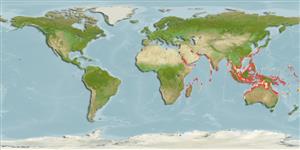Common names from other countries
Classification / Names / Names
ชื่อสามัญ | ชื่อพ้อง | Catalog of Fishes (gen., sp.) | ITIS | CoL | WoRMS
Environment: milieu / climate zone / depth range / distribution range
นิเวศวิทยา
; ระดับความลึก 0 - 37 m (Ref. 96968). Tropical
Indo-West Pacific.
Length at first maturity / ขนาด / น้ำหนัก / Age
Maturity: Lm ? range ? - ? cm Max length : 48.0 cm TL เพศผู้/กระเทย; (Ref. 96968)
Mantle length is 5.8 cm. Species is known for its mimicry of toxic models that co-occur in the same habitat, namely banded soles, sea snakes, and lionfish, with other distinct postures and behaviors currently being open to interpretation (Ref. 96968). This octopus often occupies the vacated burrows of other animals. These lairs appear temporary or may form a network of regular lairs within a home range. Individuals were observed to occupy a particular hole for periods of between one to four days. Some individuals were observed to leave one hole at first light, forage throughout the day (including entering and exiting from various animal burrows throughout the day) and remain overnight within the last hole encountered during foraging bouts. These animals were observed to emerge from the same hole at first light the next day (Ref. 96968). Active during the day. Feeds on crustaceans and fishes (Ref. 7940).
Life cycle and mating behavior
วัยเจริญพันธุ์ | การสืบพันธุ์ | การวางไข่ | เซลสืบพันธ์ของเพศเมีย(ไข่) | ความดกของไข่ | ตัวอ่อน
Members of the class Cephalopoda are gonochoric. Male and female adults usually die shortly after spawning and brooding, respectively. Mating behavior: Males perform various displays to attract potential females for copulation. During copulation, male grasp the female and inserts the hectocotylus into the female's mantle cavity where fertilization usually occurs. Life cycle: Embryos hatch into planktonic stage and live for some time before they grow larger and take up a benthic existence as adults.
Norman, M.D. and F.G. Hochberg. 2005. (Ref. 7940)
IUCN Red List Status (Ref. 130435)
CITES status (Ref. 108899)
Not Evaluated
Not Evaluated
Threat to humans
Harmless
Human uses
| FishSource |
เครื่องมือ
ข้อมูลเพิ่มเติม
Age/Size
การเจริญเติบโต
Length-weight
Length-length
สัณฐานวิทยา
ตัวอ่อน
อุดมสมบรูณ์
แหล่งที่มาจากอินเตอร์เน็ต
Estimates based on models
Preferred temperature
(Ref.
115969): 24.8 - 29.3, mean 28.5 (based on 3299 cells).
